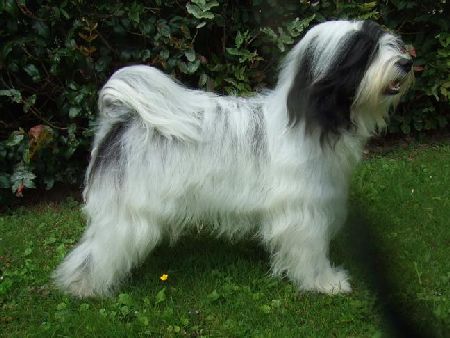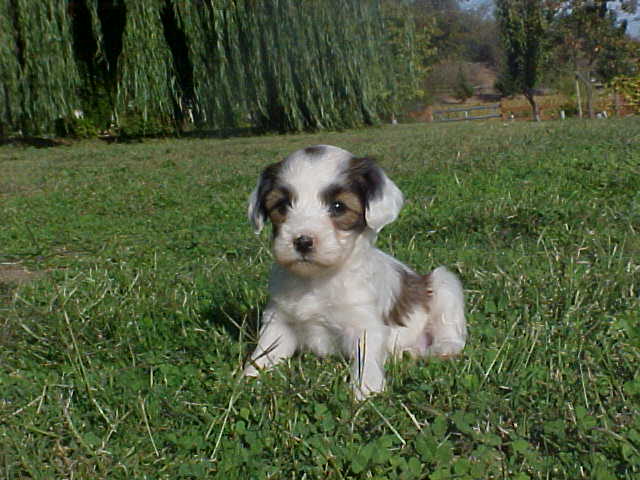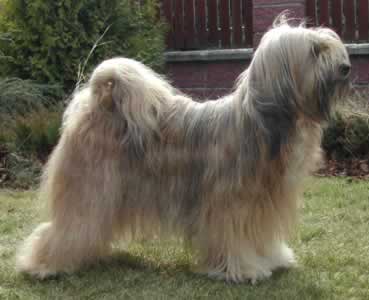| |
|
|
Tibetan Terrier Information

Tibetan Terrier Facts
| Size |
Small |
| Male Max Weight |
20-24 lb |
| Female Max Weight |
20-24 lb |
| Life Span |
12-15 years |
| Energy Level |
 |
| Ease of Training |
 |
| Grooming |
 |
| Shedding |

|
| Exercise Requirements |

|
| Playfulness |

|
| Affection Level |

|
| Good With Dogs |

|
| Good With Pets |

|
| Good With Strangers |

|
| Watchdog Ability |

|
| Protection Ability |

|
| Cold Tolerance |

|
| Heat Tolerance |

|
Tibetan Terrier Temperament
|
The Tibetan Terrier is a very sweet and gentle breed. It is very friendly with
its owners and family. As a companion, it is wonderful and can be a great indoor-dog as well as
a great outdoor-dog. It loves adventure and loves to play in big open fields. It also enjoys
sitting and playing in the yard, as it loves to be outside. Indoors it tends to be more calm
and will catch a nap wherever it is nice and cozy. It loves to please its owner and family
members and is very sensitive at times. It is a great breed for any family that has children
because it gets along very well with kids. Also, due to its energy level, it can keep up with
kids as well! They make great partners.
|
Tibetan Terrier Upkeep
|
Taking care of a Tibetan Terrier is fairly easy. Because of its adventurous,
curious side, it needs to be allowed to run around and explore new things every day. It does
require daily moderate exercise as well. It can be exercised in your yard, if it is fenced in,
or if it is taken on a long walk while using a leash. It can also be taken along for a short
run, but may not have a very high stamina; it tends to have smaller, intense bursts of energy.
Its coat needs groomed at least twice a week because it has a long
coat.
|
Tibetan Terrier Health
|
The Tibetan Terrier, like most breeds, does have its own various health
concerns that tend to target this pup. On a more serious level, things like lens luxation and
PRA are often found and these can be very threatening to the dogs everyday health. Some minor
concerns that do not cause as much damage as the aforementioned items, include patellar
luxation, cataracts of the eyes, Chronic Hip Dysplasia, croid lopfuscinosis, and
hypothyroidism. These are scene is the Tibetan Terrier pretty often but they are not a huge
threat. However, they do need to be taken seriously and tended to if your terrier begins to
show any signs of developing any of these conditions. Sometimes, owners will see distichiasis
but that tends to be rare. Suggested tests for your pooch include eye tests, hip tests, and
thyroid tests on a semi-regular basis. This will track your dog’s health so you can be
red-flagged if there are any sudden changes. If you keep your dog healthy, he will live for
anywhere from 12 to 15 years!
|
Tibetan Terrier History
|
The history of this breed is quite fascinating as it was initially bred in
monasteries almost 2000 years ago. They were regarded as family members and occasionally helped
out herding the family animals. However, it was not a worker. They were known to bring good
luck to their families and were coined “holy dogs.” There are many urban legends about how this
breed came to be, but they are only myths. The breed was first recognized in India and
eventually came to America in the 1950’s. It was admitted to the AKC in 1973.
|
Tibetan Terrier Pictures
|
Puppies

Middle Aged

Older

|
Tibetan Terrier Videos
|
|
|






